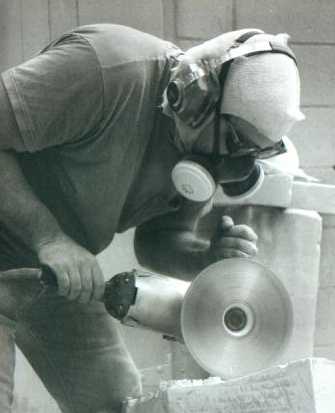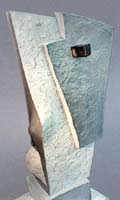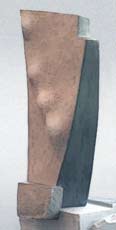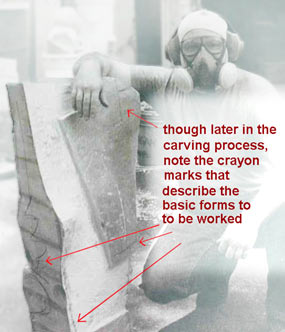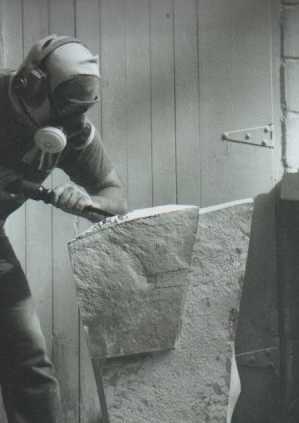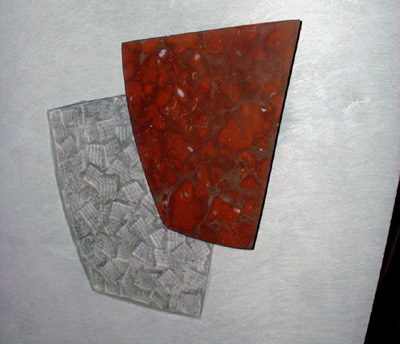 | ||||
 | ||||
Cutting into the surface of the bardiglio marble with a dry-cutting diamond-saw blade mounted on a right-angle grinder.
THREE HILLS FOR REMUS
detail
italian gray marble (bardiglio)
The block of bardiglio from which these sculptures were made was roughly the same shape as the finished pieces, except it was about twice as thick in depth as either of the finished pair.
The first stage of the work was to divide the original half-ton plus block in two by splitting it with some simple tools
called feathers and wedges.
After the block was split into two halves, the design of the piece was worked directly from the shape of the block of material without model or preliminary drawings.
The contours of the form were roughly sketched on the surface of the stone with crayon to indicate waste material to be cut away. Developing the form goes hand-in-hand with determining the surface textures of the different areas of the form.
Existing naturally-split surfaces were going to be retained in areas of the design, other areas were going to be polished, and yet others were going to have a tooled surface for contrast.
The split surfaces were a 'given', so the forms and other textures developed in relation to those surfaces. As the carving progressed the forms and plans for surface textures changed and evolved in response to the progression.
For relatively large works like ROMULUS and REMUS the carving process usually begins with the use of power tools.
 | ||||
Power tools allow the form to be developed relatively quickly at the cost of some loss of control over the definition of form. During the rough stages of work relatively tight control is not as important as relative speed of carving.
www.dondougan.com
DON DOUGAN
Material, Tool and Process: essential design elements
For me the process of making sculpture is varied - though I usually employ stone as one (or more) of the materials in a particular work, I rarely use stonecarving as the only process to create the piece of sculpture. However, the traditional method and processes of working stone are the foundations for understanding many of the additional techniques and processes that I also use.
By familiarizing myself with the basic traditional methods and tools for working stone I gain insight into the parameters of working in multi-media sculpture.
The basic methods and tools for working stone by hand have remained unchanged for centuries, though a few technological achievements have dramatically altered the inherent potentials for the contemporary sculptor. By understanding the basic processes the impact of those few improvements and additions to the sculptor's toolkit becomes easier to assess.
The great Rumanian sculptor Brancusi said,
" . . . you cannot make what you want to make, but what
the material permits you to make. You cannot make out
of marble what you would make out of wood, or out of
wood what you would make out of stone."
By this simple factual statement we are given to understand one of the essential underlying principles of contemporary sculpture in general, and in my own sculpture as well.
 | ||||
I am guided towards content by process.
By discovering how the material is affected by the tools, I also discover what the material can express of its own nature.
Through the relationship of nature and form, the material can be used to give meaning to the work. The physical nature of the material and how it can be manipulated directly affects conception of the work.
In other words, the rational structuring of the concept arises from the material itself, following my understanding of the qualities I perceive of the material through my senses.
When I combine materials in my work, it is because the combination of materials will convey a more coherent and fulfilling statement of concept; usually a concept that is derived from the very use of those materials.
FOUR HILLS FOR ROMULUS
detail
italian gray marble (bardiglio)
 | ||||
This initial splitting was simply done to make the
stone a manageable size, given the tools and
facilities available at the time.
It was only after I ended up with the two blocks
that I decided I would make them into a pair.
 | ||||
home / about the artist / stoneboat series / lipwork series / metaphorical presences / landscapes / multi-element installation pieces / recent works
technical processes / thumbnail galleries / Cortona foundry / Finland stone carving / recommended reading / all in the family / links page
 | ||||
 | ||||
Carving the bardiglio with a 3/4" pneumatic hammer and high-carbon steel chisel.
I attempt to use the unique qualities of each material so as to enhance the expression of my ideas. The choice and juxtapositions of contrasting or complementary qualities often leads me towards the form the sculpture takes. In seeking out the unique qualities of each material I can expand my sculptural vocabulary. By increasing my awareness of the nature of material, I can better choose and manipulate material in order to signify content.
left:
The piece of French red Mabre du Roi was fitted into a a matching recess in the surface of the Italian Bardiglio, echoed by a shallower 'shadow' recess with tooth-chiseled texture.
